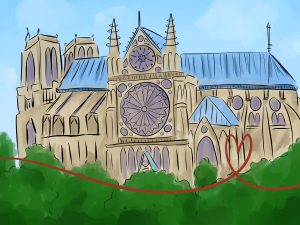Evey King
News Writer
[email protected]

Callous embers of circumstance struck the revered cathedral, Notre Dame de Paris as relentless flames enveloped its ancient roof and spire earlier this week, resulting in the loss of priceless 12th and 13th century timbers and roofing from the original construction.
“The fire started in the attic. And they did not have proper firewalls and sprinkler systems in place. They knew that it was a huge risk but did not install those mechanisms to prevent fires because they felt it might compromise the original architecture and beauty of the space,” Said Allison Weems, a French lecturer at UNC Asheville.
According to Weems, two-thirds of the roof was destroyed though the altar remains in tact. The nave itself where people worshipped was also not harmed as it was on the ground floor. However, there is a giant hole in the ceiling from where the fire had started.
“The firefighters in Paris, 500 of which were fighting this fire, regularly train in Notre Dame de Paris. So they were well aware of what procedures needed to be followed and how to fight a fire at that particular cathedral. They were prepared. It’s just an unfortunate accident,” Weems said.
French officials do not currently know the cause of the fire and it will be a while before they are able to determine it. There was no loss of human life being that there were only 12 people working on the cathedral and none of them were present when the fire broke out.
“Macron gave a speech and he promised that he would try to rebuild it in five years, which seems kind of lofty,” Weems said. “Louis Vuitton, the big conglomerate, is supposedly offering hundreds of millions of dollars. I’ve heard a total of 600 million was offered by big benefactors and companies in France.”
Weems noted that one could donate directly to Notre Dame de Paris cathedral via their website. Being a professor in French and self-described “Francophile”, Weems is deeply saddened by the news.
“I think people go there maybe as religious pilgrims, maybe just as curious non-religious visitors, but regardless of your religious affiliation or not I would daresay you cannot not walk into that cathedral and feel some sort of spirit,” Weems said. “For me that spirit is why this is so significant to France. Just think about this cathedral, they started building it in 1163. It took 200 years or so to build. It wasn’t finished until the 14th century and so many significant moments in France’s history have transpired there. Napoleon was coronated there, the bells rang at the end of World War I and World War II, it survived the French revolution in 1789 and it’s just the cradle of the French but also humanity.”
The cathedral was built quite literally on the foundation of France, a Roman outpost called Lutetia. In front of the building is Point zéro des routes de France, the point in which all distances in France are measured.
Weems thought it was important to consider that the Reims cathedral, one of the sister cathedrals of Notre Dame, caught fire both in the middle ages and 1914 during WWI and was able to be rebuilt and restored.
“This is just so symbolic of life. It’s tragedy, but amidst tragedy there’s hope and there’s opportunity to learn and grow and be born again. To come back better than you were pre-tragedy,” Weems said.
Kelly Biers, another lecturer in French at UNCA, had many thoughts and questions on the matter.
“It also gives us some things to ponder: how will it be rebuilt and what will it mean for 21st century France? Can we take the pain we felt watching Notre Dame burn and feel the same compassion for others around the world who have lost important symbolic and functional religious gathering places? Can we have these discussions without minimizing anyone’s pain?” Biers said.
While the Notre Dame de Paris is a church, it also serves as a cultural and historical site for the people of France, receiving around 13 million visitors annually. In perspective the Biltmore estate in Asheville only gets around 1 million per year.
“For many in France, especially but not exclusively Catholics, the cathedral is a place of beauty and peace, and a place for all to gather. People all around the world of all religions were saddened. I saw French Muslims on Twitter sending messages of comfort to their Catholic compatriots,” Biers said, “It’s also a symbol of hope and perseverance, surviving the Revolution and two world wars. And really, the fact is that it is still standing with several important features from the original structure still intact. That and the fact that it has recently brought so many people together is something to celebrate.”
A history student at UNCA, Abby Houghton, has visited the Notre Dame cathedral before the incident and was taken aback by the news.
“I was honestly a little more of a mess than I’d thought I’d be. My nana texted me saying ‘Did you hear about this?’ and I looked it up and I couldn’t really believe that something like that would happen. It was just a weird moment. I had so many questions in my head,” Houghton said.
Houghton said she now has a lot of respect and appreciation for the cathedral, however she had some frustrations and mixed feelings about how different tragedies such as this are treated.
“I think for one it’s amazing that if something like that were to happen people can come together and put money into things and figure things out so quickly. But it’s also frustrating because there’s other things going on in the world. You don’t need a billion dollars to fix that. If people have all this money then why isn’t Flint, Michigan’s water fixed yet? It’s also a world tragedy and something we are going to be talking out for ages,” Houghton said.


![Brooke Pedersen [second from the right] and Luis Reyes [right] hold banners during the Wrap The Woods event.](https://thebluebanner.net/wp-content/uploads/2025/09/ELIZABETH_PRITCHITT_IMG_3470-1200x804.jpg)



















